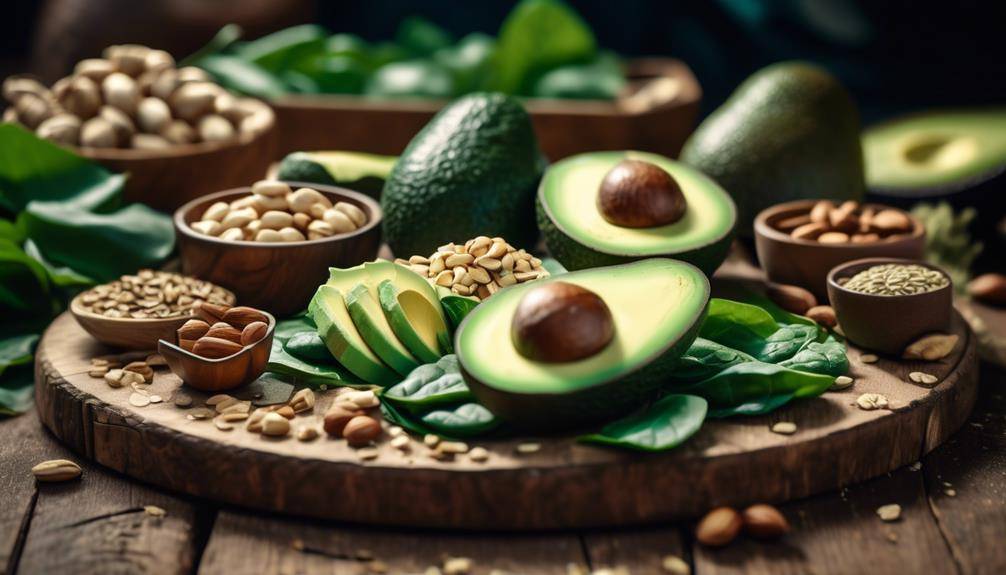Popular Ketogenic Diet Principles for Vegetarians

Ketogenic Diet Principles for Vegetarians; Imagine you’re a vegetarian on a quest to explore the benefits of the ketogenic diet. It’s like embarking on a culinary adventure, where the familiar landscape of grains and legumes gives way to a new terrain of healthy fats, low-carb vegetables, and plant-based protein. But how exactly can you navigate this uncharted territory, where the principles of a meat-centric diet clash with your vegetarian lifestyle? I
n this discussion, we’ll unravel the secrets of the vegetarian ketogenic diet, providing you with practical tips, insightful guidance, and a roadmap to help you achieve and maintain ketosis while staying true to your vegetarian values. So, get ready to embark on this journey of culinary discovery and unlock the potential of a vegetarian keto lifestyle.
Understanding the Ketogenic Diet
To understand the ketogenic diet, you need to grasp the fundamental principles and mechanics behind it. The ketogenic diet is a high-fat, low-carbohydrate, and moderate-protein eating plan that aims to induce a metabolic state called ketosis. Ketosis occurs when your body doesn’t have enough carbohydrates to use as its primary source of energy, so it starts breaking down fats instead. This process produces ketones, which your body can use for fuel.
One of the main benefits of a ketogenic diet is its potential for weight loss. When you restrict your carbohydrate intake, your body has to turn to its fat stores for energy. This can lead to a significant reduction in body weight, especially in the form of body fat. Additionally, the ketogenic diet has been shown to help control appetite and cravings, making it easier to stick to a calorie-restricted eating plan.
Another advantage of the ketogenic diet is its potential to improve certain health markers. Research suggests that this diet may help lower blood sugar levels, reduce insulin resistance, and improve insulin sensitivity. These effects can be particularly beneficial for individuals with type 2 diabetes or prediabetes. Additionally, the ketogenic diet has been shown to increase levels of HDL cholesterol (the “good” cholesterol) while decreasing levels of LDL cholesterol (the “bad” cholesterol), which can have a positive impact on heart health.
Vegetarian Sources of Healthy Fats
Including vegetarian sources of healthy fats in your ketogenic diet can help provide essential nutrients and support overall health. While the ketogenic diet typically emphasizes the consumption of animal-based fats, vegetarians can still enjoy a wide variety of keto-friendly recipes that incorporate plant-based fats.
One of the main benefits of healthy fats in a vegetarian diet is their ability to promote satiety. Fats take longer to digest compared to carbohydrates, keeping you feeling full and satisfied for longer periods of time. This can be especially beneficial for individuals on a ketogenic diet, as it helps control cravings and promotes weight loss.
Avocados are an excellent source of healthy fats and are a staple in many vegetarian keto recipes. They are rich in monounsaturated fats, which have been associated with a reduced risk of heart disease. Additionally, avocados are packed with fiber, vitamins, and minerals, making them a nutritious addition to any meal.
Another great vegetarian source of healthy fats is nuts and seeds. These include almonds, walnuts, chia seeds, and flaxseeds. These foods are not only high in healthy fats but also provide a good amount of protein and fiber. They can be incorporated into your diet as a snack or added to salads, smoothies, or keto-friendly baked goods.
Coconut oil is another popular choice for vegetarians on a ketogenic diet. It is high in medium-chain triglycerides (MCTs), which are easily converted into ketones by the liver and can be used as a source of energy. Coconut oil can be used for cooking, baking, or added to smoothies for an extra boost of healthy fats.
Incorporating these vegetarian sources of healthy fats into your ketogenic diet can provide numerous benefits, including improved satiety, heart health, and increased energy levels. Experiment with different recipes and find what works best for you to create a well-rounded and sustainable ketogenic diet.
Incorporating Low-Carb Vegetables Into Your Diet
Incorporating a variety of low-carb vegetables into your diet can provide essential nutrients and support the principles of a ketogenic lifestyle. Vegetables are not only low in carbohydrates but also rich in vitamins, minerals, and fiber. They can add color, flavor, and texture to your meals, making them more enjoyable and satisfying.
One of the benefits of incorporating low-carb vegetables into your diet is that they are packed with nutrients. Vegetables like spinach, kale, and broccoli are excellent sources of vitamins A, C, and K, as well as minerals like iron and calcium. These nutrients are essential for maintaining good health and supporting various bodily functions.
Another advantage of low-carb vegetables is their high fiber content. Fiber is known to promote healthy digestion, regulate blood sugar levels, and support weight management. By including a variety of low-carb vegetables in your meals, you can increase your fiber intake and improve your overall gut health.
To incorporate more low-carb vegetables into your ketogenic diet, you can try out various delicious recipes. Some popular options include cauliflower rice, zucchini noodles, and roasted Brussels sprouts. These recipes not only provide a low-carb alternative to traditional dishes but also offer a tasty and satisfying way to enjoy your vegetables.
Navigating the World of Vegetarian Protein
When following a ketogenic diet as a vegetarian, it’s important to navigate the world of vegetarian protein to ensure you meet your nutritional needs. Fortunately, there are plenty of protein-rich plant alternatives available, such as tofu, tempeh, seitan, and legumes. Additionally, understanding essential amino acids and protein combining techniques can help you optimize your protein intake and ensure you’re getting all the necessary building blocks for your body.
Protein-Rich Plant Alternatives
To ensure an adequate protein intake while following a vegetarian ketogenic diet, explore the wide variety of plant-based alternatives available. There are numerous plant-based protein sources that can help you meet your protein needs without compromising your vegetarian lifestyle. Legumes such as lentils, chickpeas, and black beans are excellent sources of protein and can be incorporated into various high-protein vegetarian recipes.
Additionally, tofu, tempeh, and edamame are rich in protein and can be used as versatile meat substitutes in your ketogenic meals. Nuts and seeds, such as almonds, chia seeds, and hemp seeds, also provide a good amount of protein. You can add them to your salads, smoothies, or even enjoy them as a snack. By incorporating these plant-based protein alternatives into your diet, you can easily maintain a vegetarian ketogenic lifestyle while ensuring you meet your protein requirements.
Essential Amino Acids
One way to navigate the world of vegetarian protein is by understanding the importance of essential amino acids. These are the building blocks of proteins and play a crucial role in various physiological processes, including protein synthesis and muscle growth. While it is possible to obtain essential amino acids from plant-based sources, vegetarian diets may sometimes lack certain amino acids in sufficient quantities.
In such cases, amino acid supplementation can be considered to ensure an adequate intake. Branched-chain amino acids (BCAAs) like leucine, isoleucine, and valine, for example, are essential for protein synthesis and muscle growth. Including BCAA-rich foods such as legumes, nuts, and seeds in your diet can help meet your amino acid needs. Understanding the importance of essential amino acids can be beneficial for vegetarians looking to optimize their protein intake for muscle growth and overall health.
Protein Combining Techniques
Understanding effective protein combining techniques is essential for vegetarians looking to optimize their protein intake and ensure they are meeting their nutritional needs. By using these techniques, vegetarians can create complete protein sources that contain all the essential amino acids necessary for the body’s functions. Here are four protein combining techniques that can help vegetarians meet their protein requirements:
- Pairing legumes with grains: Legumes and grains, such as rice and beans, complement each other by providing different essential amino acids. By combining the two, you create a complete protein source.
- Combining legumes with nuts or seeds: Legumes are low in the amino acid methionine, while nuts and seeds are rich in it. Pairing legumes with nuts or seeds helps balance the amino acid profile.
- Adding dairy or eggs to plant-based meals: Dairy products and eggs are complete protein sources. Adding them to plant-based meals can enhance the overall protein content and quality.
- Utilizing protein-rich vegetarian alternatives: There are various vegetarian protein alternatives available, such as tofu, tempeh, seitan, and quinoa. These can be used as standalone protein sources or combined with other plant-based proteins to create complete protein meals.
The Role of Dairy and Eggs in a Vegetarian Keto Diet
When following a vegetarian keto diet, dairy options can play a crucial role in meeting your protein and fat needs. Incorporating dairy products such as cheese, yogurt, and heavy cream can provide essential nutrients while keeping carb intake low. Eggs, another versatile source of protein, can also be included in your vegetarian keto diet to enhance satiety and support muscle growth.
Dairy Options for Vegetarians
Dairy and eggs play a significant role in a vegetarian ketogenic diet, providing essential nutrients and versatile options for maintaining ketosis. Here are four dairy options for vegetarians to consider:
- Full-fat dairy products: These include cheese, butter, and heavy cream, which are all low in carbs and high in fat, making them suitable for a ketogenic diet.
- Greek yogurt: This protein-rich dairy option is a great source of probiotics, calcium, and vitamin B12. Opt for full-fat Greek yogurt and avoid flavored varieties to keep carb intake low.
- Coconut milk and cream: For those following a dairy-free or vegan ketogenic diet, coconut milk and cream are excellent alternatives. They are high in healthy fats and can be used in various recipes.
- Nut-based milks: Non-dairy milk options like almond milk, cashew milk, and macadamia milk can be consumed in moderation on a vegetarian keto diet. However, always check the labels for added sugars and choose unsweetened varieties.
Including these dairy options in your vegetarian ketogenic diet can help you meet your nutrient needs while staying in ketosis.
Incorporating Eggs Into Keto
To incorporate eggs into a vegetarian ketogenic diet, you can rely on their versatility and nutrient profile to support your ketosis goals. Eggs are an excellent source of high-quality protein, healthy fats, and essential vitamins and minerals. They are low in carbs and can be easily incorporated into various keto-friendly recipes.
Eggs can be enjoyed in many ways, such as scrambled, boiled, or used as an ingredient in dishes like omelets and frittatas. They can also serve as a substitute for other high-carb ingredients, such as flour or breadcrumbs, in keto baking. The benefits of eggs in a ketogenic diet include promoting satiety, supporting muscle growth, and providing necessary nutrients. Including eggs in your vegetarian keto diet can help you meet your macro and micronutrient needs while staying in ketosis.
Using Nuts and Seeds for Added Nutritional Value
For added nutritional value, incorporating nuts and seeds into your ketogenic vegetarian diet is a beneficial choice. Nuts and seeds are not only delicious and versatile, but they also provide a wide range of essential nutrients that can support your overall health and well-being. Here are four reasons why including nuts and seeds in your ketogenic diet can be advantageous:
- Rich in Healthy Fats: Nuts and seeds are packed with heart-healthy fats, such as monounsaturated and polyunsaturated fats. These fats are essential for maintaining proper brain function, supporting cardiovascular health, and reducing inflammation in the body.
- Excellent Source of Plant-Based Protein: If you’re following a vegetarian ketogenic diet, nuts and seeds can be an excellent source of plant-based protein. They contain all the essential amino acids needed for your body’s growth, repair, and maintenance.
- Fiber Powerhouse: Nuts and seeds are also high in dietary fiber, which is crucial for maintaining a healthy digestive system. Fiber helps regulate blood sugar levels, promotes satiety, and supports healthy weight management.
- Packed with Essential Nutrients: Nuts and seeds are a nutrient-dense food, meaning they provide a wide array of essential vitamins and minerals. They are particularly rich in vitamin E, magnesium, zinc, and selenium, which are vital for various bodily functions, including immune support and antioxidant protection.
Incorporating a variety of nuts and seeds into your ketogenic vegetarian diet can provide you with numerous health benefits. However, remember to consume them in moderation, as they are calorie-dense. You can enjoy them as a snack, add them to salads, or use them as a topping for your ketogenic dishes to enhance both the flavor and nutritional value of your meals.
Creative Ways to Replace High-Carb Ingredients
To continue expanding your repertoire of ketogenic vegetarian dishes, explore creative ways to replace high-carb ingredients with healthier alternatives. By making low carb ingredient swaps, you can create delicious and satisfying meals that align with the principles of the ketogenic diet. Here are some creative keto recipes that can help you replace high-carb ingredients while still enjoying flavorful meals.
One common high-carb ingredient in many dishes is pasta. But fear not, as there are several low carb alternatives available. For example, you can use spiralized zucchini or spaghetti squash as a replacement for traditional pasta. These vegetables are low in carbs and high in nutrients, providing a delicious and healthy base for your favorite sauces.
Another high-carb ingredient that can be easily replaced is rice. Cauliflower rice is a popular low carb substitute that can be used in various dishes. Simply grate or pulse cauliflower in a food processor until it reaches a rice-like consistency. You can then use it as a base for stir-fries, curries, or even as a side dish.
If you’re craving bread or wraps, there are also low carb options available. Lettuce leaves or large collard greens can be used as wraps for sandwiches or tacos. Additionally, you can make your own bread using almond or coconut flour, which are both low in carbs and high in healthy fats.
When it comes to desserts, traditional high-carb ingredients like sugar and flour can be replaced with low carb alternatives. For example, you can use almond flour or coconut flour instead of wheat flour, and natural sweeteners like stevia or erythritol instead of sugar. These swaps will allow you to enjoy delicious keto-friendly desserts without compromising your dietary goals.
Meal Planning for a Vegetarian Keto Lifestyle
Planning your meals is an essential aspect of maintaining a vegetarian keto lifestyle. By carefully meal prepping and incorporating vegetarian protein alternatives, you can ensure that you’re getting the nutrients you need while following a ketogenic diet. Here are four key steps to help you with meal planning for a vegetarian keto lifestyle:
- Plan your meals in advance: Take the time to sit down and plan out your meals for the week. This will help you stay organized and ensure that you have all the necessary ingredients on hand. Consider including a variety of vegetarian protein sources such as tofu, tempeh, seitan, and legumes to meet your protein needs.
- Focus on low-carb vegetables: Fill your plate with non-starchy vegetables that are low in carbohydrates. These include leafy greens, broccoli, cauliflower, zucchini, and bell peppers. These vegetables are not only nutritious but also provide fiber, which is important for maintaining a healthy gut.
- Incorporate healthy fats: To meet your fat requirements on a vegetarian keto diet, include sources such as avocados, nuts, seeds, and plant-based oils like olive oil and coconut oil. These fats will not only keep you full and satisfied but also provide essential nutrients like omega-3 fatty acids.
- Experiment with recipes: Don’t be afraid to get creative in the kitchen. Look for vegetarian keto recipes that use ingredients like almond flour, coconut flour, and flaxseed meal as alternatives to traditional high-carb ingredients. This will help you enjoy a variety of flavors while sticking to your vegetarian keto lifestyle.
The Importance of Electrolytes on a Keto Diet
Now let’s shift our focus to the importance of electrolytes on a keto diet, as they play a crucial role in maintaining proper bodily function and overall health. Electrolytes are minerals that carry an electric charge when dissolved in water. These include sodium, potassium, magnesium, and calcium. On a ketogenic diet, maintaining the right balance of electrolytes is essential due to the increased excretion of water and electrolytes in the initial stages of ketosis.
Electrolyte balance is vital for various bodily functions, including nerve transmission, muscle contraction, and maintaining proper pH levels. When you limit your carbohydrate intake on a keto diet, your body starts using fat as its primary source of energy. As a result, insulin levels decrease, leading to increased urine production. This can cause an imbalance in electrolyte levels, leading to symptoms such as muscle cramps, fatigue, and dizziness.
To maintain proper electrolyte balance on a keto diet, it is essential to incorporate hydration techniques. Firstly, ensure you drink enough water throughout the day. Adequate hydration helps regulate electrolyte levels and prevents dehydration. Additionally, consider adding electrolyte-rich foods to your diet, such as avocados, leafy greens, nuts, and seeds. These foods contain minerals like potassium and magnesium, which are crucial for maintaining electrolyte balance.
You can also supplement with electrolyte powders or tablets to ensure you are getting enough electrolytes. Look for products that contain sodium, potassium, and magnesium. However, be cautious with the sodium content, as excessive sodium intake can lead to high blood pressure. It’s important to consult with a healthcare professional or registered dietitian before starting any supplementation.
Avoiding Hidden Carbohydrates in Vegetarian Foods
When following a ketogenic diet as a vegetarian, it is important to be aware of hidden sources of carbohydrates in vegetarian foods. Many plant-based foods that are commonly consumed by vegetarians contain higher amounts of carbohydrates than one might expect. By identifying these hidden carb sources and opting for low-carb vegetarian alternatives, you can successfully adhere to a ketogenic diet while still maintaining your vegetarian lifestyle.
Hidden Carb Sources
Have you ever wondered where hidden carbohydrates might be lurking in vegetarian foods? While vegetarian meals can be a great choice for those following a ketogenic diet, it’s important to be aware of hidden carb sources. Here are some common places where carbohydrates might be hiding in your vegetarian dishes:
- Sauces and dressings: Many store-bought sauces and dressings contain added sugars or high-carb ingredients. Opt for homemade versions using low-carb sweeteners or vinegar-based dressings.
- Legumes and beans: While legumes and beans are excellent sources of protein for vegetarians, they also contain carbs. Be mindful of portion sizes to keep your carb intake in check.
- Grains and starchy vegetables: Foods like rice, pasta, potatoes, and corn are high in carbohydrates. Consider swapping them out for low-carb alternatives like cauliflower rice or zucchini noodles.
- Hidden sugars: Be cautious of hidden sugars in vegetarian processed foods, such as veggie burgers, canned soups, and packaged snacks. Always check the nutrition label for carb content.
Low-Carb Vegetarian Alternatives
To avoid hidden carbohydrates in vegetarian foods, consider incorporating low-carb alternatives that can help you maintain your ketogenic diet. While many vegetarian foods are naturally low in carbs, some can still contain hidden sources of carbohydrates. By being aware of these hidden carbs and making smart choices, you can stay on track with your vegetarian keto meal plan.
Opt for low-carb vegetables such as leafy greens, broccoli, and cauliflower as the base for your meals. Incorporate plant-based protein sources like tofu, tempeh, and seitan, which are low in carbs and high in protein. You can also experiment with vegetarian keto recipes that use alternative flours like almond flour or coconut flour instead of traditional grain-based flours. These low-carb alternatives will help you enjoy a variety of delicious meals while staying in ketosis.
Achieving and Maintaining Ketosis as a Vegetarian
In order to achieve and maintain ketosis as a vegetarian, it is important to carefully plan your meals to ensure you are consuming adequate amounts of healthy fats and minimal carbohydrates. Here are four key points to consider when following a vegetarian ketogenic diet:
- Focus on plant-based protein options: As a vegetarian, it’s crucial to find alternative sources of protein to meet your daily requirements. Incorporate foods such as tofu, tempeh, seitan, and edamame into your meals. These plant-based protein sources are low in carbs and high in protein, making them ideal for a ketogenic diet.
- Include plenty of healthy fats: Healthy fats play a vital role in a vegetarian ketogenic diet. Avocados, nuts, seeds, and oils like coconut oil and olive oil are excellent sources of healthy fats. These fats not only provide energy but also help keep you feeling full and satisfied throughout the day.
- Minimize carbohydrate intake: To achieve and maintain ketosis, it’s essential to limit your carbohydrate intake. Opt for low-carb vegetables like spinach, kale, cauliflower, and zucchini. These vegetables are not only packed with essential nutrients but also low in carbohydrates, making them suitable for a vegetarian ketogenic diet.
- Plan your meals ahead of time: Planning your meals in advance can help ensure you’re meeting your nutritional needs while staying in ketosis. Consider creating a meal plan that includes vegetarian keto meal examples like cauliflower rice stir-fry with tofu, avocado and spinach salad with nuts, or a veggie omelet cooked in coconut oil.
Tracking Macros and Adjusting Your Diet as Needed
To effectively track your macros on a vegetarian keto diet, you need to understand the basics. This involves calculating your daily macronutrient needs, including the right balance of carbohydrates, protein, and fat. By using online tools and apps, you can easily track your macros and make adjustments to your diet as needed to maintain ketosis and meet your nutritional goals.
Macro Tracking Basics
Consider tracking your macros and adjusting your diet as necessary to ensure you are meeting your nutritional needs while following a ketogenic diet as a vegetarian. Tracking macros can be a useful tool to help you stay on track and make sure you are getting the right balance of nutrients. Here are four macro tracking basics to help you get started:
- Calculate your macros: Use a macro calculator to determine your daily macronutrient goals. This will give you a target for how much protein, fat, and carbohydrates you should be consuming each day.
- Track your food intake: Use a food tracking app or journal to record everything you eat and drink. This will allow you to see how your macros add up throughout the day and make adjustments if needed.
- Adjust your diet: If you find that you are not meeting your macro goals, you may need to make changes to your diet. This could involve increasing or decreasing certain foods to ensure you are hitting your targets.
- Monitor your progress: Regularly review your macro tracking data to see how you are progressing towards your goals. This will help you identify any areas where you may need to make further adjustments to optimize your diet.
Adapting Vegetarian Keto Diet
To adapt a vegetarian keto diet, it is important to track your macros and adjust your diet as necessary. Tracking your macros involves keeping an eye on your intake of carbohydrates, protein, and fat. As a vegetarian on a keto diet, you will need to find alternative sources of protein and fat that are low in carbohydrates. Good sources of protein include tofu, tempeh, seitan, and eggs. For fats, you can rely on avocados, nuts, seeds, and plant-based oils like coconut oil or olive oil. It’s important to note that not all vegetarian foods are keto-friendly, as some may contain hidden carbohydrates.
To ensure you’re staying on track, it’s recommended to use a food tracking app or website to help you keep a detailed record of your macros. Adapting to a vegetarian keto diet may require some experimentation and adjustments to find the right balance of nutrients for your body.
Combining Intermittent Fasting With a Vegetarian Keto Diet
Intermittent fasting can be successfully combined with a vegetarian ketogenic diet to optimize health and achieve weight loss goals. By incorporating intermittent fasting into your vegetarian keto lifestyle, you can further enhance the benefits of both approaches. Here are four tips to help you combine intermittent fasting with a vegetarian keto diet:
- Time-restricted eating: Adopt a time-restricted eating window, such as the 16/8 method, where you consume all your daily calories within an 8-hour window and fast for the remaining 16 hours. This can help regulate insulin levels and promote fat burning.
- Focus on nutrient-dense foods: Ensure that your vegetarian keto meals are packed with essential nutrients. Include a variety of plant-based proteins, such as tofu, tempeh, and seitan, as well as healthy fats from sources like avocados, nuts, and seeds. Incorporate plenty of low-carb vegetables to provide fiber, vitamins, and minerals.
- Stay hydrated: Drink plenty of water throughout the day to support digestion, detoxification, and overall health. Hydration is especially important during fasting periods to prevent dehydration and help curb hunger.
- Monitor your macros and calories: While following a vegetarian keto diet, it’s crucial to track your macronutrient intake and ensure you’re in a state of ketosis. Use a food diary or a mobile app to monitor your daily calorie and macronutrient consumption to maintain the desired balance.
Seeking Professional Guidance and Support
To ensure you receive accurate guidance and support while following a vegetarian ketogenic diet combined with intermittent fasting, it is advisable to seek professional assistance from a qualified healthcare provider or registered dietitian. Seeking professional guidance is crucial for a number of reasons.
Firstly, a healthcare provider or registered dietitian can provide you with personalized meal planning that aligns with your specific dietary needs and goals. They can help you create a well-balanced vegetarian ketogenic diet that includes all the necessary nutrients while keeping your carbohydrate intake low. This is important to ensure that you meet your nutritional requirements and maintain your health throughout your journey.
Additionally, a professional can assist you in effectively tracking your macronutrients. The ketogenic diet relies on achieving specific macronutrient ratios, with a focus on high fat and low carbohydrate intake. Tracking your macros accurately is essential to achieve and maintain a state of ketosis, where your body burns fat for fuel instead of carbohydrates. A healthcare provider or registered dietitian can guide you in accurately measuring and tracking your macros to ensure you stay on track.
Moreover, seeking professional support can provide you with the necessary knowledge and guidance to address any potential challenges or concerns that may arise. They can help you navigate through the initial adaptation phase, where you may experience symptoms like the “keto flu,” and provide strategies to minimize discomfort. They can also monitor your progress and make necessary adjustments to your diet and fasting schedule based on your individual response.
Ketogenic Diet Principles for VegetariansFrequently Asked Questions
Can I Still Achieve Ketosis on a Vegetarian Keto Diet?
Yes, you can achieve ketosis on a vegetarian keto diet. It requires careful planning and selecting low-carb, high-fat vegetarian foods. Benefits include weight loss and improved blood sugar control, but challenges may arise due to limited food choices.
What Are Some Low-Carb Vegetarian Protein Sources?
Some low-carb vegetarian protein sources include tofu, tempeh, seitan, and edamame. These high fat vegetarian sources can be beneficial for a vegetarian keto diet by providing essential nutrients while keeping carb intake low.
How Can I Incorporate Intermittent Fasting Into a Vegetarian Keto Diet?
To incorporate intermittent fasting into a vegetarian keto diet, start by gradually increasing your fasting window. This can have benefits like improved insulin sensitivity and weight loss. To maintain muscle mass, focus on consuming enough protein from vegetarian sources.
Are There Any Vegetarian Foods That Might Contain Hidden Carbohydrates?
When following a vegetarian keto diet, it’s important to be mindful of hidden carbohydrates in certain foods. To avoid this, read labels carefully and opt for vegetarian keto friendly snacks that are low in carbs.
Is It Necessary to Track Macros and Adjust My Diet as a Vegetarian on a Keto Diet?
Yes, it is necessary to track macros and adjust your diet when following a vegetarian keto diet. This ensures you are getting the right balance of nutrients and staying in ketosis.
Conclusion
In conclusion, a vegetarian ketogenic diet can be achieved by incorporating healthy fats, low-carb vegetables, and vegetarian sources of protein. Dairy and eggs can also play a role in meeting nutritional needs. It is important to track macros and adjust the diet as needed to achieve and maintain ketosis. Combining intermittent fasting with a vegetarian keto diet may also be beneficial. Seeking professional guidance and support can further optimize success on this dietary approach.








